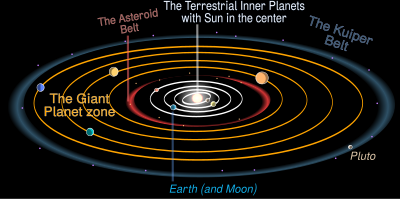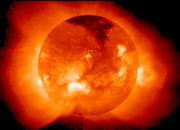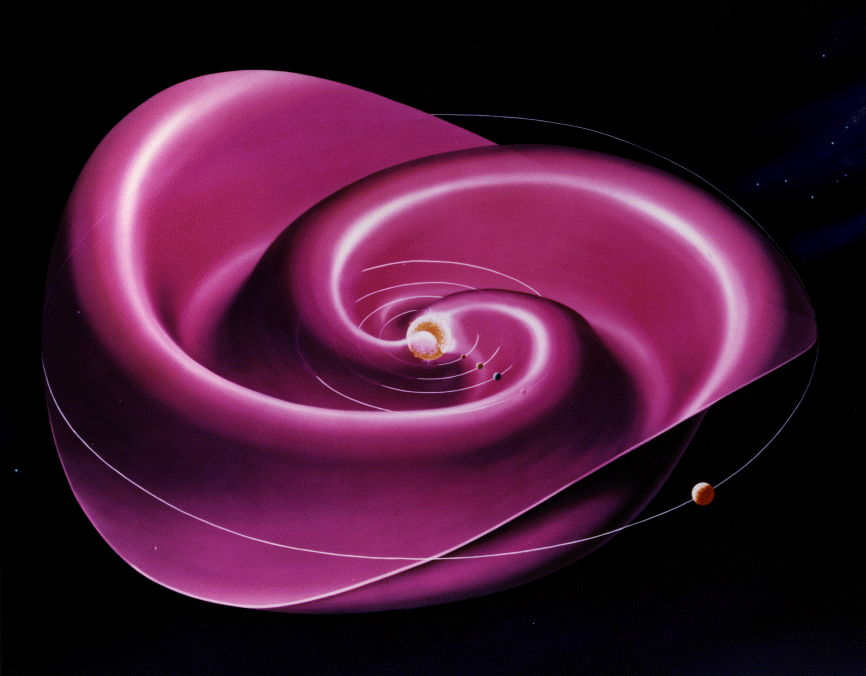The Solar System[a] consists of the Sun and those celestial objects bound to it by gravity. These objects are the eight planets, their 166 known moons,[1] five dwarf planets, and billions of small bodies. The small bodies include asteroids, icy Kuiper belt objects, comets, meteoroids, and interplanetary dust.
The charted regions of the Solar System are the Sun, four terrestrial inner planets, the asteroid belt, four gas giant outer planets, the Kuiper belt and the scattered disc. The hypothetical Oort cloud may also exist at a distance roughly a thousand times beyond the charted regions.
A flow of plasma from the Sun (the solar wind) permeates the Solar System. This creates a bubble in the interstellar medium known as the heliosphere, which extends out to the middle of the scattered disc.
In order of their distances from the Sun, the eight planets are:
As of mid-2008, five smaller objects are classified as dwarf planets. Ceres is in the asteroid belt, and four orbit the Sun beyond Neptune: Pluto (formerly classified as the ninth planet), Haumea, Makemake, and Eris.
Six of the planets and three of the dwarf planets are orbited by natural satellites, usually termed "moons" after Earth's Moon. Each of the outer planets is encircled by planetary rings of dust and other particles.
Discovery and exploration
For many thousands of years, humanity, with a few notable exceptions, did not recognise the existence of the Solar System. They believed the Earth to be stationary at the centre of the universe and categorically different from the divine or ethereal objects that moved through the sky. Although the Indian mathematician-astronomer Aryabhata and the Greek philosopher Aristarchus of Samos had speculated on a heliocentric reordering of the cosmos, Nicolaus Copernicus was the first to develop a mathematically predictive heliocentric system. His 17th-century successors Galileo Galilei, Johannes Kepler, and Isaac Newton developed an understanding of physics which led to the gradual acceptance of the idea that the Earth moves around the Sun and that the planets are governed by the same physical laws that governed the Earth. In more recent times, this led to the investigation of geological phenomena such as mountains and craters and seasonal meteorological phenomena such as clouds, dust storms and ice caps on the other planets.
Structure
The principal component of the Solar System is the Sun, a main sequence G2 star that contains 99.86 percent of the system's known mass and dominates it gravitationally.[2] Jupiter and Saturn, the Sun's two largest orbiting bodies, account for more than 90 percent of the system's remaining mass.[b]
Most large objects in orbit around the Sun lie near the plane of Earth's orbit, known as the ecliptic. The planets are very close to the ecliptic while comets and Kuiper belt objects are usually at significantly greater angles to it.
All of the planets and most other objects also orbit with the Sun's rotation (counter-clockwise, as viewed from above the Sun's north pole). There are exceptions, such as Halley's Comet.
Kepler's laws of planetary motion describe the orbits of objects about the Sun. According to Kepler's laws, each object travels along an ellipse with the Sun at one focus. Objects closer to the Sun (with smaller semi-major axes) have shorter years. On an elliptical orbit, a body's distance from the Sun varies over the course of its year. A body's closest approach to the Sun is called its perihelion, while its most distant point from the Sun is called its aphelion. Each body moves fastest at its perihelion and slowest at its aphelion. The orbits of the planets are nearly circular, but many comets, asteroids and Kuiper belt objects follow highly elliptical orbits.
To cope with the vast distances involved, many representations of the Solar System show orbits the same distance apart. In reality, with a few exceptions, the farther a planet or belt is from the Sun, the larger the distance between it and the previous orbit. For example, Venus is approximately 0.33 astronomical units (AU)[c] farther out than Mercury, while Saturn is 4.3 AU out from Jupiter, and Neptune lies 10.5 AU out from Uranus. Attempts have been made to determine a correlation between these orbital distances (see Titius-Bode law), but no such theory has been accepted.
Most of the planets in the Solar System possess secondary systems of their own. Many are in turn orbited by planetary objects called natural satellites, or moons, some of which are larger than planets. Most of the largest natural satellites are in synchronous orbit, with one face permanently turned toward their parent. The four largest planets also possess planetary rings, thin bands of tiny particles that orbit them in unison.
Terminology
Informally, the Solar System is sometimes divided into separate regions. The inner Solar System includes the four terrestrial planets and the main asteroid belt. The outer Solar System is beyond the asteroids, including the four gas giant planets.[3] Since the discovery of the Kuiper belt, the outermost parts of the Solar System are considered a distinct region consisting of the objects beyond Neptune.[4]
Dynamically and physically, objects orbiting the Sun are classed into three categories: planets, dwarf planets and small Solar System bodies. A planet is any body in orbit around the Sun that has enough mass to form itself into a spherical shape and has cleared its immediate neighbourhood of all smaller objects. By this definition, the Solar System has eight known planets: Mercury, Venus, Earth, Mars, Jupiter, Saturn, Uranus, and Neptune. Pluto was demoted from planetary status, as it has not cleared its orbit of surrounding Kuiper belt objects.[5] A dwarf planet is a celestial body orbiting the Sun that is massive enough to be rounded by its own gravity but which has not cleared its neighbouring region of planetesimals and is not a satellite.[5] By this definition, the Solar System has five known dwarf planets: Ceres, Pluto, Haumea, Makemake, and Eris.[6] Other objects that may become classified as dwarf planets are Sedna, Orcus, and Quaoar. Dwarf planets that orbit in the trans-Neptunian region are called "plutoids."[7] The remainder of the objects in orbit around the Sun are small Solar System bodies.[5]
Planetary scientists use the terms gas, ice, and rock to describe the various classes of substances found throughout the Solar System. Rock is used to describe compounds with high melting points (greater than roughly 500 K), such as silicates. Rocky substances are prevalent in the inner Solar System, forming most of the terrestrial planets and asteroids. Gases are materials with low melting points such as atomic hydrogen, helium, and noble gases; they dominate the middle region, comprising most of Jupiter and Saturn. Ices, like water, methane, ammonia, and carbon dioxide,[8] have melting points up to a few hundred Kelvin. Icy substances comprise the majority of the satellites of the giant planets, as well as most of Uranus and Neptune (the so-called "ice giants") and the numerous small objects that lie beyond Neptune's orbit.[9] The term volatiles refers collectively to all materials with low boiling points (less than a few hundred Kelvin), including gases and ices; depending on the temperature, volatiles can be found as ices, liquids, or gases in various places in the Solar System.
Sun
The Sun is the Solar System's parent star, and far and away its chief component. Its size is 332,830 Earth masses. This large mass gives it an interior density high enough to sustain nuclear fusion, which releases enormous amounts of energy, mostly radiated into space as electromagnetic radiation such as visible light.
The Sun is classified as a moderately large yellow dwarf, but this name is misleading as, compared to stars in our galaxy, the Sun is rather large and bright. Stars are classified by the Hertzsprung-Russell diagram, a graph which plots the brightness of stars against their surface temperatures. Generally, hotter stars are brighter. Stars following this pattern are said to be on the main sequence; the Sun lies right in the middle of it. However, stars brighter and hotter than the Sun are rare, while stars dimmer and cooler are common.[10]
It is believed that the Sun's position on the main sequence puts it in the "prime of life" for a star, in that it has not yet exhausted its store of hydrogen for nuclear fusion. The Sun is growing brighter; early in its history it was 70 percent as bright as it is today.[11]
The Sun is a population I star; it was born in the later stages of the universe's evolution. It contains more elements heavier than hydrogen and helium ("metals" in astronomical parlance) than older population II stars.[12] Elements heavier than hydrogen and helium were formed in the cores of ancient and exploding stars, so the first generation of stars had to die before the universe could be enriched with these atoms. The oldest stars contain few metals, while stars born later have more. This high metallicity is thought to have been crucial to the Sun's developing a planetary system, because planets form from accretion of metals.[13]
Interplanetary medium
Along with light, the Sun radiates a continuous stream of charged particles (a plasma) known as the solar wind. This stream of particles spreads outwards at roughly 1.5 million kilometres per hour,[14] creating a tenuous atmosphere (the heliosphere) that permeates the Solar System out to at least 100 AU (see heliopause). This is known as the interplanetary medium. Geomagnetic storms on the Sun's surface, such as solar flares and coronal mass ejections, disturb the heliosphere, creating space weather.[15] The Sun's rotating magnetic field acts on the interplanetary medium to create the heliospheric current sheet, the largest structure in the Solar System.[16]

Earth's magnetic field protects its atmosphere from interacting with the solar wind. Venus and Mars do not have magnetic fields, and the solar wind causes their atmospheres to gradually bleed away into space.[17] The interaction of the solar wind with Earth's magnetic field creates the aurorae seen near the magnetic poles.
Cosmic rays originate outside the Solar System. The heliosphere partially shields the Solar System, and planetary magnetic fields (for those planets that have them) also provide some protection. The density of cosmic rays in the interstellar medium and the strength of the Sun's magnetic field change on very long timescales, so the level of cosmic radiation in the Solar System varies, though by how much is unknown.[18]
The interplanetary medium is home to at least two disc-like regions of cosmic dust. The first, the zodiacal dust cloud, lies in the inner Solar System and causes zodiacal light. It was likely formed by collisions within the asteroid belt brought on by interactions with the planets.[19] The second extends from about 10 AU to about 40 AU, and was probably created by similar collisions within the Kuiper belt.





Tidak ada komentar:
Posting Komentar